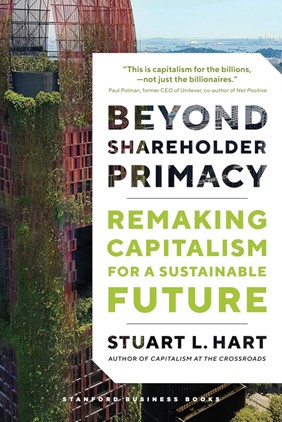Book Review - Beyond Shareholder Primacy: Remaking Capitalism For A Sustainable Future

Beyond Shareholder Primacy: Remaking Capitalism For A Sustainable Future by Stuart L. Hart. Stanford: Stanford University Press, Stanford Business Books 2024. 369 pp., $35 hardcover 9781503636217, e-book 9781503638747
For decades, the publishing industry has been churning out books instructing the world how to smooth the rough edges of capitalism, and make it work for everyone. Since the onset of the environmental movement, there has been a particular glut of publications sublimating capitalism into a green gospel. It, however, has been seldom that an accomplished business professor pens a tome that burns with a trenchant critique of capitalism, and an urgent call for its just and sustainable version. Stuart Hart has seamlessly pulled off this formidable intellectual feat.
In Beyond Shareholder Primacy, he comes off as Marx echoing Adam Smith, and Adam Smith reverberating Marx, although his referencing of Marx is as sparse as Adam Smith’s is generous. His thesis that centers his book is deceptively simple: capitalism has hollowed itself out by putting shareholders’ interests above all else, which must change. This change will herald capitalism’s third transformation that Hart highlights as “just and sustainable.”
 He echoes his fellow scholar Paul Polman who questions capital’s tendency to serve the shareholder class. Polman denounces this tendency in a memorable phrase: “This is capitalism for the billions, not just the billionaires.” Hart was so much taken with Polman’s searing but aphoristic observation that he prefaced the title of his book with it. He, however, does not think that shareholder capitalism can ever speak to the needs and aspirations of the billions. He demonstrates to the contrary, emphasizing its continued tendency to pamper the shareholder class that endangers society, climate, and the planet – in that order.
He echoes his fellow scholar Paul Polman who questions capital’s tendency to serve the shareholder class. Polman denounces this tendency in a memorable phrase: “This is capitalism for the billions, not just the billionaires.” Hart was so much taken with Polman’s searing but aphoristic observation that he prefaced the title of his book with it. He, however, does not think that shareholder capitalism can ever speak to the needs and aspirations of the billions. He demonstrates to the contrary, emphasizing its continued tendency to pamper the shareholder class that endangers society, climate, and the planet – in that order.
Hence the need for making it “just and sustainable,” which most critics (and even champions) of capitalism will agree. But how? By reversing the primacy of shareholders that “came to be known as … the (Milton) Friedman Doctrine of profit maximization” (p.155). After studying the long-arc history of capitalism, Hart shows that this reversal is possible. He optimistically concludes that capitalism has gone through several iterations since the fifteenth century, and is now on the cusp of its third incarnation. He grandly tags this process as “Remaking capitalism for a sustainable future,” which is the subtitle of his book.
Beyond Shareholder Primacy is a sequel of Capitalism at the Crossroads that Hart wrote about twenty years ago. Capitalism at the Crossroads did not have the same sharp tone or radical critique that one finds in Beyond Shareholder Primacy. Yet some readers commented to Hart that the title – Capitalism at the Crossroads – “seemed a bit “over the top”” (p.301). It is this kind of complacent (or complicit) defense of capitalist excesses that engenders strong reactions in an array of movements which catalyze all that is wrong with contemporary capitalism. Hart invokes Carl Jung who captured this reaction with an esoteric but instructive descriptor: Enantiodromia. Jung states that “the emergence of new unconscious ideas occurs when an extreme one-sided tendency dominates conscious life; eventually an equally strong countervailing tendency builds: euphoria becomes melancholy; valued becomes worthless; and good becomes the bad” (p. 3). The primal forces or “animal spirits” of greed, extraction, and lust for power lead to “an extreme, one-sided tendency toward exploitation, concentration of wealth, and degradation of the social fabric and environment. Such excesses then produce a countermovement … (of) compassionate forces – empathy, mutuality, concern for the common good – (that) lead to new “reformed” version of capitalism” (p. 5). Hart illustrates with Enantiodromia the challenges of modern society in “Brexit in Europe, rising nationalism, and the resurgence of strongmen around the world” (p. 3).
He sacralizes the remaking of capitalism as “Reformation” in the mold of Martin Luther’s 95 Theses that challenged the Catholic Church, triggering a religious, political, and intellectual transformation. Hart defends usage of the term “reformation” because religious and ideological ferment drove the “crusaders for the various forms of capitalism throughout history” (p.6). Since the Protestant Reformation, Hart documents, capitalism has undergone three major reformations of its own. Mercantile capitalism in the 17th-18th century produced its antithesis in market capitalism that Hart calls capitalism’s first reformation. Monopoly capitalism in the 19th-20th century led to its mellowing in welfare capitalism that Hart dubs as capitalism’s second reformation. Shareholder (or neoliberal) capitalism, which took root in the 1980s, is hoped to yield its third reformation in a “just and sustainable capitalism”, which Hart passionately advocates for.
He divides the book into three parts. Part-1, in three chapters, sums up the history of the origin of capitalism to its contemporary version. Part-II, in another three chapters, offers ways and means to build sustainable capitalism. Part-III lays out a plan for system change, emphasizing the reinvention of business education, and redefining “value.” Part-I, consisting of chapters 1-3, is the main course, the sumptuousness of which one cannot get enough of. In these three chapters, Hart deftly condenses the 500-year history of capital transformation into four lessons, three of which are most noteworthy: (a) self-interest is not selfishness but serving others; (b) monopolies override the societal benefits of “market” economies by allowing the capitalist class to concentrate industries and wealth; and (c) reinvestment precedes extraction of wealth, i.e., reinvestment is the founding purpose of capitalism, not profit maximization or shareholders’ primacy.
Hart persuasively demonstrates how the age of exploration and the age of extraction – from Christopher Columbus to Vasco da Gama to the British East India Company – contributed to the rise of capitalism, and accompanied brutal violence that even Adam Smith denounced. Some of the vignettes in these chapters may be news to the younger generation of capitalists and even that of some scholars. For instance, Adam Smith was a “professor of moral philosophy” (p.32) at Glasgow, to the contrary but putative assumption that he was an economist. Hart notes with irony that the discipline of economics was founded a century after Adam Smith left this planet. He rates his The Theory of Moral Sentiments higher than The Wealth of Nations. Much of Hart’s critique of shareholder capitalism is informed by and grounded in The Theory of Moral Sentiments. It is Adam Smith who defines ‘self-interest’ as ‘serving others’ or gives primacy to ‘reinvestment’ over ‘profit maximization’ in the interest of job growth and by extension serving others.
Hart asserts how shareholder capitalism, over the decades, branded the world with ecological and social scars. He definitively notes that “there is little disagreement that the last half century – the age of shareholder capitalism – has been a time of accelerating disruption, contributing significantly to the breaching of planetary boundaries and widening of inequality. Some have even suggested renaming the new epoch the Capitalocene, to highlight the responsibility of capitalism, rather than humanity in general, for precipitating our current predicament” (p. 302).
Hart apparently resents the label of Capitalocene and analogizes it to the blame game and doom-mongering that he claims will “do us little good.” Instead, he proposes that “… what we need now more than anything else is a new story – a new “myth” to live and work by, one that offers the possibility of a sustainable future. And given the outsized role of shareholder capitalism in creating the problem over the past four decades, the new myth must necessarily be accompanied by a new operating system for business” (p. 302). Surprisingly, Hart’s entire treatise is about blaming shareholder capitalism for its ecological and social excesses, and yet he finds the neologism of Capitalocene more offensive than his own critique of capitalism, although a valid one.
Elsewhere, he eloquently faults shareholder capitalism for its obsession with short-termism: “The creation of long-term societal value should drive stock price, not short-term profits” (p.12). Again, while succinctly listing the ecological and social predicaments of our times, he blames them on shareholder capitalism: “… the challenges we now face – the climate crisis, environmental degradation, toxic inequality, structural racism – present existential threats: we have run out of “on-ramp” and there is no time to waste … Will a new sustainable and inclusive form of capitalism overtake and make obsolete the extractive and inequitable shareholder capitalism that has ruled the world for the past forty years?” (p. 8).
Hart even invokes Marx in denunciation of violent capitalism: “…the alienation of man thus appears as the fundamental evil of capitalist society” (p. 39). In contrast to Hart’s critique of capitalism, his conclusions and inferences remind one of British philosopher Mark Fisher’s cutting remark (originally attributed to philosophers Fredric Jameson and Slavoj Zizek): “it is easier to imagine an end to the world than an end to capitalism.” Yet Beyond Shareholder Primacy is a treat to both defenders and detractors of capitalism. Stuart Hart shines with empathy, intellect, and wisdom in every page of this volume that is destined to become a classic.
Tarique Niazi, Ph.D. is a Professor of Environmental Sociology at the University of Wisconsin at Eau Claire, Wisconsin, U.S.A.


